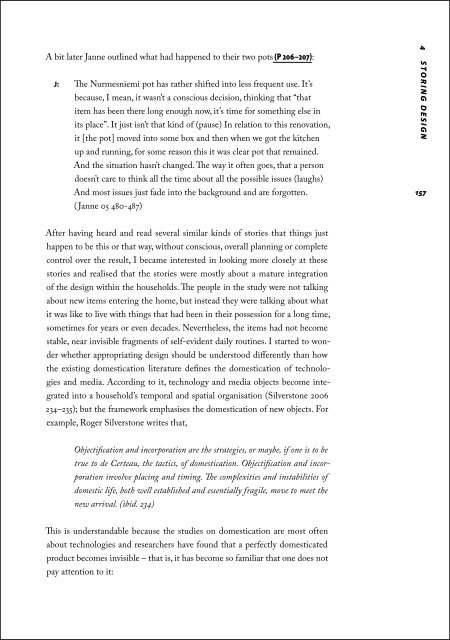Lataa ilmaiseksi
Lataa ilmaiseksi
Lataa ilmaiseksi
Create successful ePaper yourself
Turn your PDF publications into a flip-book with our unique Google optimized e-Paper software.
A bit later Janne outlined what had happened to their two pots (P 206–207):<br />
J: The Nurmesniemi pot has rather shifted into less frequent use. It’s<br />
because, I mean, it wasn’t a conscious decision, thinking that “that<br />
item has been there long enough now, it’s time for something else in<br />
its place”. It just isn’t that kind of (pause) In relation to this renovation,<br />
it [the pot] moved into some box and then when we got the kitchen<br />
up and running, for some reason this it was clear pot that remained.<br />
And the situation hasn’t changed. The way it often goes, that a person<br />
doesn’t care to think all the time about all the possible issues (laughs)<br />
And most issues just fade into the background and are forgotten.<br />
( Janne 05 480-487)<br />
4 S T O R I N G D E S I G N<br />
157<br />
After having heard and read several similar kinds of stories that things just<br />
happen to be this or that way, without conscious, overall planning or complete<br />
control over the result, I became interested in looking more closely at these<br />
stories and realised that the stories were mostly about a mature integration<br />
of the design within the households. The people in the study were not talking<br />
about new items entering the home, but instead they were talking about what<br />
it was like to live with things that had been in their possession for a long time,<br />
sometimes for years or even decades. Nevertheless, the items had not become<br />
stable, near invisible fragments of self-evident daily routines. I started to wonder<br />
whether appropriating design should be understood differently than how<br />
the existing domestication literature defines the domestication of technologies<br />
and media. According to it, technology and media objects become integrated<br />
into a household’s temporal and spatial organisation (Silverstone 2006<br />
234–235); but the framework emphasises the domestication of new objects. For<br />
example, Roger Silverstone writes that,<br />
Objectification and incorporation are the strategies, or maybe, if one is to be<br />
true to de Certeau, the tactics, of domestication. Objectification and incorporation<br />
involve placing and timing. The complexities and instabilities of<br />
domestic life, both well established and essentially fragile, move to meet the<br />
new arrival. (ibid. 234)<br />
This is understandable because the studies on domestication are most often<br />
about technologies and researchers have found that a perfectly domesticated<br />
product becomes invisible – that is, it has become so familiar that one does not<br />
pay attention to it:
















